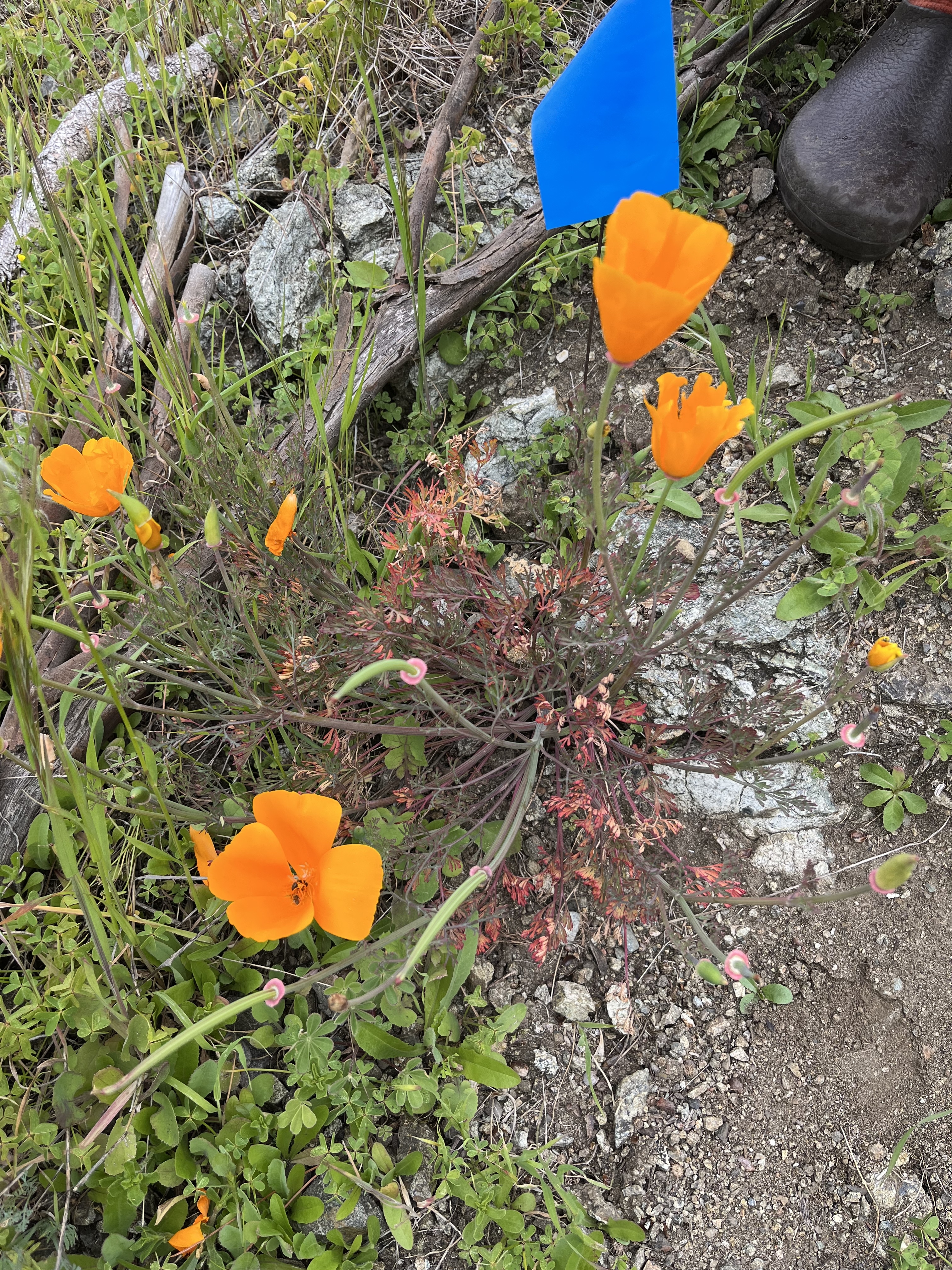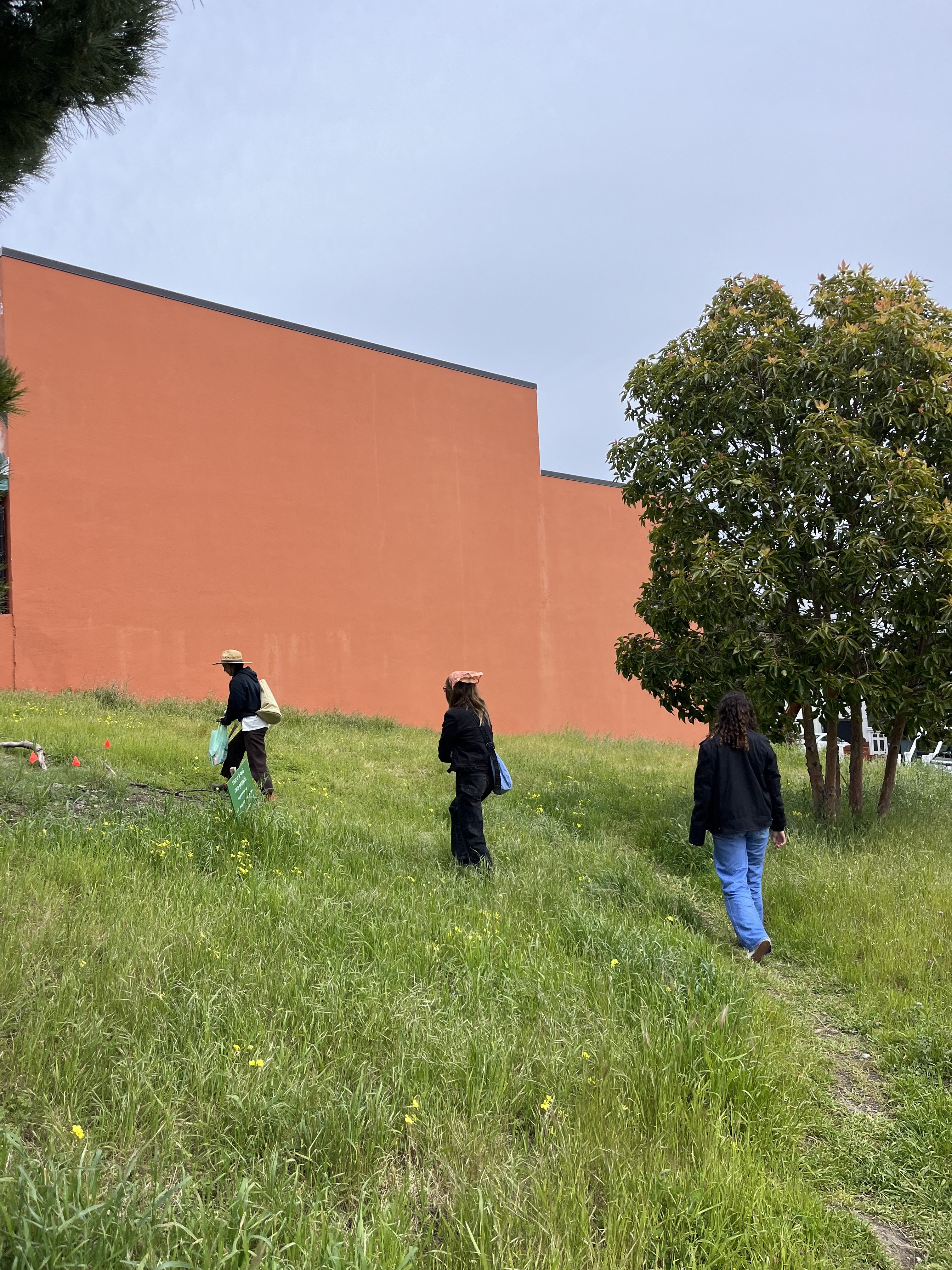A NEW YEAR AT STARR KING
Starr King Test Plot
By Théa Ryan
DATE: March 30 2025
The past few months have been an evolving dance of observing, tweaking, and nudging. The Purple needlegrass (Stipa pulchra) plugs were planted in the fall, and we’ve learned to distinguish it from the many other grasses on site - it’s blueish green, it can withstand a strong tug, the blades are stiffer than others. It was also planted in groups of three in the poppy plot which helps us to know which were transplants and which were pre-existing (this technique is borrowed from the Skyline Gardens playbook). We continue to apply the Bradley Method, clearing as many non-native species directly embedded in and around the native species we are trying to support. In the poppy plot, the main native plants we’re seeing are Naked buckwheat (Eriogonum nudum), Arroyo lupine (Lupinus succulentus), California poppy (Eschscholzia californica), Soap plant (Chlorogalum pomeridiamun) and purple needlegrass.
Starr King Test Plot
By Théa Ryan
DATE: March 30 2025
The past few months have been an evolving dance of observing, tweaking, and nudging. The Purple needlegrass (Stipa pulchra) plugs were planted in the fall, and we’ve learned to distinguish it from the many other grasses on site - it’s blueish green, it can withstand a strong tug, the blades are stiffer than others. It was also planted in groups of three in the poppy plot which helps us to know which were transplants and which were pre-existing (this technique is borrowed from the Skyline Gardens playbook). We continue to apply the Bradley Method, clearing as many non-native species directly embedded in and around the native species we are trying to support. In the poppy plot, the main native plants we’re seeing are Naked buckwheat (Eriogonum nudum), Arroyo lupine (Lupinus succulentus), California poppy (Eschscholzia californica), Soap plant (Chlorogalum pomeridiamun) and purple needlegrass.
The poppy plot now has minimal weeds, which will ideally give the native plants more space to grow - however, it is also wide open for more non-natives to move in. The ground is hot, crumbly and dry. The poppies started blooming in mid-February - we noticed one plant growing directly on serpentinite that has brown and red-tinged leaves. I asked a CA native Facebook group for their take and learned that environmental stress can cause the plant to produce more anthocyanins (creating the reddish color). This tracks with the harsh chemical makeup of serpentine soils. Other poppies on the same plot don’t exhibit the same colors - does it have to do with proximity to the actual serpentinite? Just a guess. The lupines followed in late February after a very hot (70°F) day. The heat also welcomed more birds and butterflies. On February 26th, we spotted a pair of Painted Lady (Vanessa cardui) butterflies and a flock of 16 western meadowlarks flying through the site.


Over at the pine plot, we’re seeing a high concentration of naturally-occuring purple needlegrass fighting for its place among the encroaching oxalis and non-native grasses. We heard mention that there may have been a fire on the site at some point - possible connection? Sarah Burton helped track down some local history and we discovered there had indeed been a fire in 2015 at this exact site. It was about 2-4 square meters, and locals observed a higher occurence of purple needlegrass and Dotseed plantain (Plantago erecta) the following spring, which is exactly what we’re seeing! While this may have been a case of arson, it’s very exciting to have living proof of the benefits of fire. Another serpentine grassland in San Francisco’s Presidio was the site of a controlled burn in 2007. We’re asking ourselves about the logistics of requesting a controlled burn, and residents’ perceptions of fire.
The tiniest plant observed on the pine plot, dotseed plantain, is generating a lot of excitement for us. In its early stages, we were often stumped as to what was and wasn’t dotseed plantain. With time, it formed its signature cottony head and became much easier to identify. Dotseed plantain is an unassuming but very important plant for our native pollinators - it’s the primary host plant for the Bay checkerspot butterfly (Euphydryas editha bayensis), a federally threatened species endemic to the area.
One theme that keeps coming up for us is having a reference site. We’re thinking about reaching out to the folks at the Presidio to learn about the methods they’ve used on their serpentinite grasslands. Another much more proximate site is the open space just across the street. Some of the current natives in bloom in the open space are Blue dicks (Dipterostemon capitatus), Blue-eyed grass (Sisyrinchium bellum), Harvest brodiaea (Brodiaea elegans), California goldfields (Lasthenia californica), Miniature lupine (Lupinus bicolor), Checkerbloom (Sidalcea malviflora), Shining pepperweed (Lepidium nitidum) and Purplespot gilia (Gilia clivorum). Having a sister site to compare techniques, disturbances, and species distribution is a wonderfully collaborative way for us to learn from one another.
Speaking of techniques, we’ve been experimenting with the scythe with mixed results (we think it needs more/better sharpening), and using a hyper-localized vinegar spray on the weeds in the poppy plot. We’re avoiding any weeds that are very close to the native plants so as not to risk spraying the natives. It’s unclear whether hand-weeding or vinegar spraying is the more effective technique.
On our most recent visit, the purple needlegrass was blooming. We’re hoping to see some Yellow mariposa lily (Calochortus luteus), blue dicks, and maybe even some butterflies like the Acmon blue (Icaricia acmon) or Bay checkerspot if we’re lucky!


